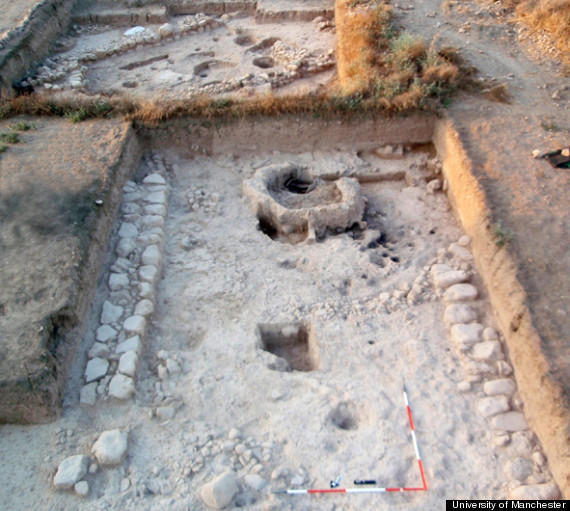Bronze Age 'Microbrewery' Unearthed At Cyprus Archaeological Site
By Rachel Tepper, The Huffington Post, 29Nov12
Archaeologists in western Cyprus are shedding light on ancient boozing after the discovery of a "microbrewery" dating to the Bronze Age, about 3,500 years ago.

The excavation includes a mud-plaster domed structure, which is thought to have been used as a kiln to dry malt. Variously flavored beers would have been brewed from the substance and fermented with yeasts, which may have been produced from grapes or figs. The resulting brew may have had an alcohol content of about 5 percent.
The University of Manchester's Dr. Lindy Crewe led the excavation, ongoing at the Early-Middle Bronze Age settlement of Kissonerga-Skalia since 2007. The discovery, she said, is quite significant:
"Archaeologists believe beer drinking was an important part of society from the Neolithic onwards and may have even been the main reason that people began to cultivate grain in the first place. ... 'But it's extremely rare to find the remains of production preserved from thousands of years ago so we're very excited."

Crewe and her team also uncovered grinding tools and mortars that may have been used to break down the grains after they had undergone the malting process, a small hearth, cooking pots and juglets, which likely contained yeast additives or beer sweeteners.
Adding fuel to the fire, beer ingredients like carbonized seeds were found on site.
The Telegraph writes that a team from Heritage and Archaeological Research Practice decided to put Crewe's theory about the kiln to the test, and set to brewing a Bronze Age beer by recreating a similar structure and employing traditional brewing techniques. Ian Hill, who led the effort, said that the resulting brews "were all pretty drinkable."
The Huffington Post reached out to the University of Manchester, who passed along the recipe for one of the brews, which they've named Kissonerga-Skalia Pale Ale. Fair warning, it sounds a bit complicated. We suggest you have an expert on hand before you attempt making it.
Ingredients:
1.5 Kg fresh, wild barley
5 large, wild figs (unwashed)
Plenty of water
Steps:
- Using a porous sack, soak 1.5 Kg of the barley grains in cool running water for 24 hours. A fresh running stream is ideal.
- Drain the grains and remove any unwanted stalks etc. Spread the grains evenly inside a semi-porous container (a shallow pottery vessel or wooden bowl for instance) and cover the container with a damp cloth and place the container out of direct sunlight.
- Uncover every 6 hours to stir the grains, so to avoid overheating and moulding and repeat until germination phase is complete (usually 3-4 days).
- Once the grains have germinated they are ready to malt. Split open a grain to check the germination, once the inner shoot of the grain has grown to around 75 percent of the length of the grain they are ready.
- To malt the grain place in open containers and put them into the bottom of your drying kiln, once positioned fire up the kiln and maintain a steady fire for 24 hours. This will produce a steady temperature of around 60?C for malting your grains to produce a pale malt.
- Once malted take your grains and crush using a quern stone and grinder, the grains should be crushed in order to open them and allow liquid so that sugars can be absorbed, but not crushed so much as to make flour.
- Heat 3.75 litres of water in a large cooking pot to between 65C and 70C. Add the crushed malt and stir through. Cover the vessel and remove from the heat, but ensure that the temperature does not fall below 65C or above 70C (if necessary add cold or hot water to help maintain the temperature) and leave to mash for 90 minutes.
- Heat a further 3.75 litres of water to 75C in a separate cooking pot and prepare a third, sealable, vessel which will be used to ferment the beer in.
- Once the mash is complete strain the contents of the mash through a porous material, such as cloth, into the fermentation vessel. The grains will be held in the cloth whilst allowing the sweet liquid wort to drain into the fermentation vessel. To get the maximum amount of sugars from the grain and into the wort take the second vessel of heated water and pour over the grains to drain into the fermentation vessel.
- Once the fermentation vessel is full, heat to a high temperature to kill any germs or bacteria. The wort must then be cooled by placing the fermentation vessel into cold water (being careful not to let any of the water into the vessel).
- Once the wort has been cooled take the figs and gently crush them in your hand before placing them inside the fermentation vessel. Seal the fermentation vessel and leave in a cool place, out of direct sunlight for 5-6 days, by which time your beer will be ready to drink.
Bronze age 'microbrewery' discovered in Cyprus
Archaeologists working in western Cyprus are raising a glass to the discovery of a Bronze Age ''microbrewery''.

The team excavated a two metres by two metres mud-plaster domed structure, which it says was used as a kiln to dry malt and make beer 3,500 years ago.
Beers of different flavours would have been brewed from malted barley and fermented with yeasts with an alcoholic content of around 5 per cent.
The yeast would have either been wild or produced from fruit such as grape or fig, according to the researchers.
Dr Lindy Crewe, from the University of Manchester, has led the excavation at the Early-Middle Bronze Age settlement of Kissonerga-Skalia, near Paphos, since 2007.
She said: ''Archaeologists believe beer drinking was an important part of society from the Neolithic onwards and may have even been the main reason that people began to cultivate grain in the first place.
''But it's extremely rare to find the remains of production preserved from thousands of years ago so we're very excited.
''The excavation of the malting kiln with associated sets of pottery types and tools left in place gives us a fantastic opportunity to look at Bronze Age tool kits and figure out techniques and recipes.''
The oven discovered by the archaeologists was positioned at one end of a 50-metre square courtyard with a plastered floor.
They found grinding tools and mortars which may have been used to break down the grain after it was malted, a small hearth and cooking pots made of clay to cook the beer gently.
They also found juglets, which they believe probably contained yeast additives or sweeteners to produce beers of different strengths or flavours. The beers' ingredients were found by the team as carbonised seeds.
Dr Crewe added: ''Beer was commonly drunk because it is more nutritious than bread and less likely to contain harmful pathogens than drinking water which can make you ill.
''But alcoholic beverages were also used to oil the wheels of business and pleasure in much the same way as today. Work brought communities together for tasks such as bringing in the harvest or erecting special buildings.
''Instead of payment, participants are rewarded with a special feast, often involving quantities of alcohol which also transformed the work from a chore into a social event.
''The people of the Bronze Age, it seems, were well aware of the relaxing properties of alcohol.''
An experimental archaeology team, led by Ian Hill of Harp (Heritage and Archaeological Research Practice) Archaeology, recreated the drying kiln using traditional techniques to test Dr Crewe's theory in August, said the university.
The modern version used hot air to produce a temperature of 65C - perfect conditions for heating and drying grains but still preserving its enzymes and proteins.
Mr Hill said: ''After the beers had been strained, we felt they were all pretty drinkable, though some varieties were better than others.
''The grape was less pleasant - a bit too sweet - the outcomes are less reliable when using wild yeasts, compared to brewer's yeast, but the fig beer was definitely the most popular.''
TOP LINKS ON THIS TOPIC
I am using the Free version of SPAMfighter.
SPAMfighter has removed 206766 of my spam emails to date.
Do you have a slow PC? Try free scan!
 Harrolds.Blogspot.com
Harrolds.Blogspot.com
No comments:
Post a Comment
Please, avoid posting advertisements. Content comments are welcomed, including anonymous. Posts with profanity will not be published.